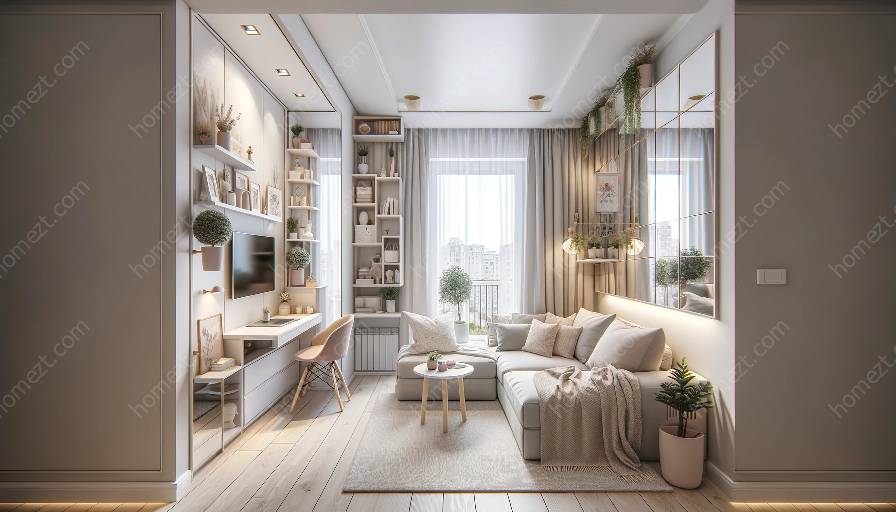Small living spaces often present a challenge when it comes to optimizing space and creating a comfortable, functional environment. One effective solution to this issue is the use of versatile furniture pieces that can contribute to maximizing space and enhancing the overall design of the interior. In this article, we will discuss the benefits of versatile furniture, explore practical tips for utilizing small spaces, and delve into creative ways to decorate effectively in compact areas.
The Role of Versatile Furniture in Small Interiors
Versatile furniture plays a crucial role in making the most of limited space. These multi-functional pieces are designed to serve multiple purposes, offering practical solutions for small interiors without compromising on style or comfort. Here are some ways versatile furniture can contribute to maximizing space:
- Space Optimization: Versatile furniture pieces, such as sofa beds, extendable dining tables, and storage ottomans, are designed to maximize space by serving multiple functions. A sofa bed, for example, can serve as a comfortable seating area during the day and transform into a bed at night, providing a dual-purpose solution for small living areas.
- Storage Solutions: Many versatile furniture pieces incorporate built-in storage to help reduce clutter and organize belongings. Coffee tables with hidden compartments, modular shelving units, and multi-tiered storage systems are examples of furniture that not only save space but also provide ample storage options for small interiors.
- Flexibility and Adaptability: Versatile furniture is known for its flexibility and adaptability. Pieces that can be easily rearranged, folded, or expanded allow for greater flexibility in small interiors. This adaptability enables homeowners to optimize the layout of their space based on their changing needs and activities.
- Visual Appeal: In addition to their practical benefits, versatile furniture pieces can enhance the visual appeal of small interiors. Cleverly designed, multi-functional furniture adds an element of sophistication and ingenuity to the decor, creating an aesthetically pleasing environment.
Tips for Utilizing Small Spaces
Utilizing small spaces effectively requires thoughtful planning and strategic decision-making. Consider the following tips to make the most of limited space:
- Multi-Purpose Zones: Define specific zones within a small interior for different activities, such as a work corner, a relaxation area, and a dining space. Utilize versatile furniture to delineate these zones and maximize functionality.
- Vertical Storage: Maximize vertical space by installing shelving, wall-mounted cabinets, and floating shelves. Vertical storage not only saves floor space but also creates visual interest and practical storage solutions.
- Flexible Furniture: Opt for furniture with flexible features, such as nesting tables, extendable dining sets, and modular seating. These pieces can be transformed and rearranged to adapt to various needs, providing versatility in a compact setting.
- Lighting Strategies: Use lighting to create the illusion of space and enhance the ambiance of small interiors. Incorporate task lighting, ambient lighting, and decorative fixtures to optimize the visual appeal of the space.
- Mirrors and Reflective Surfaces: Integrate mirrors and reflective surfaces to visually expand the space and create a sense of openness. Mirrors can amplify natural light and make small interiors feel more spacious and airy.
Decorating Small Interiors Creatively
Decorating small interiors presents an opportunity to think creatively and express personal style within a limited footprint. Consider the following tips for decorating small spaces in a creative and impactful way:
- Scale and Proportion: When selecting furniture and decor for small interiors, pay attention to scale and proportion. Choose appropriately sized pieces that complement the space without overwhelming it. Avoid bulky or oversized furniture that can make the room feel cramped.
- Cohesive Color Palette: Opt for a cohesive color scheme to create visual harmony within small interiors. Light and neutral tones can help open up the space, while pops of color can add personality and vibrancy. Consider using accent colors sparingly to avoid visual clutter.
- Multifunctional Decor: Look for decor items that serve multiple purposes, such as storage ottomans that double as seating, or decorative baskets that provide both style and organization. This approach maximizes functionality while minimizing clutter.
- Vertical Accents: Use vertical accents, such as tall indoor plants, floor-to-ceiling curtains, or vertical wall art, to draw the eye upward and create the illusion of height. This technique can make the ceilings feel higher and the space more expansive.
- Mindful Arrangement: Thoughtful arrangement of furniture and decor can significantly impact the perception of space in small interiors. Avoid overcrowding the room and prioritize open pathways and visual flow. Experiment with different layouts to find the most efficient and visually appealing arrangement.
By incorporating these tips and embracing the versatility of furniture, small interiors can be transformed into functional, stylish, and inviting spaces that make the most of every square foot.






































